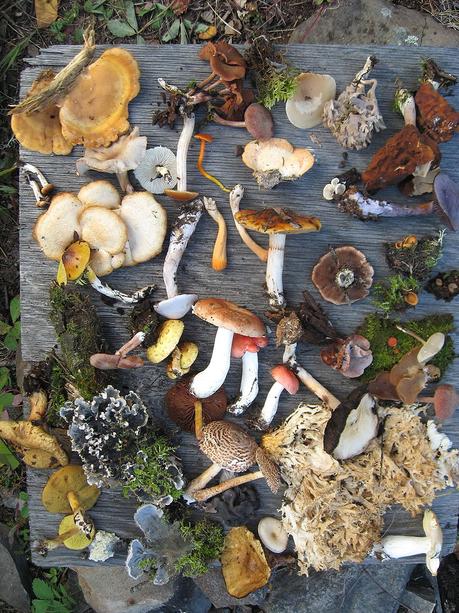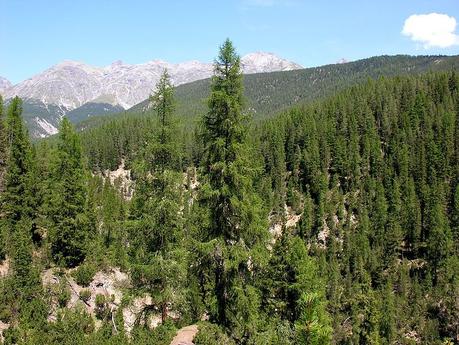Biodiversity
Definition
Biodiversity evolves from two Latin words bios meaning life and diversity meaning variety so biodiversity meaning variety of life in the earth.
[su_youtube url=”https://youtu.be/DJ_tqyDBwKo”]Diversity describes us two things firstly variety of species in the earth for example species of snake, fishes, elephant, etc, and variety within species such there are many types of fishes snake buffaloes, etc.
 Fig.1. A sampling of fungi collected during summer 2008 in Northern Saskatchewan mixed woods, near LaRonge, is an example regarding the species diversity of fungi. In this photo, there are also leaf lichens and mosses.
Fig.1. A sampling of fungi collected during summer 2008 in Northern Saskatchewan mixed woods, near LaRonge, is an example regarding the species diversity of fungi. In this photo, there are also leaf lichens and mosses.
Here are two species mentioned in detail fauna (animals) flora (plants).
 Fig.2. A conifer forest in the Swiss Alps (National Park), Showing Plant diversity
Fig.2. A conifer forest in the Swiss Alps (National Park), Showing Plant diversity
Time period
4 billion years are passed to evolve the variety of species that are present on the earth.
almost 10 million types of species are present on the earth in which only 2 million species are known so far or studies while 8 million species are unknown so far. in these 2 million species 1.5 Million animals and 0.5 M plants are studied so far. the distribution of species on the earth is not the same in the whole areas some areas have a large number of species such as forest areas and some areas which have a moderate amount of species such as under cultivated areas some have the least number of species such as as desert areas.
Significance
- biodiversity provides us food in the form of vegetable fruits and meat etc.
- A large amount of medicine directly or indirectly are getting from biodiversity. indirectly their glandular products or nectar from weeds are evolving for the formation of different types of medicine.
- a large amount of natural fibers resin gums are evolved from biodiversity.
- the raw material for making buildings, houses, etc. is getting from biodiversity.
Biodiversity Definition
“Biodiversity is the variation among living organisms from different sources including terrestrial, marine and desert ecosystems, and the ecological complexes of which they are a part.”
What is Biodiversity?
Biodiversity describes the richness and variety of life on earth. It is the most complex and important feature of our planet. Without biodiversity, life would not sustain.
The term biodiversity was coined in 1985. It is important in natural as well as artificial ecosystems. It deals with nature’s variety is biosphere. It refers to variabilities among plants, animals and microorganism species.
Biodiversity includes the number of different organisms and their relative frequencies in an ecosystem. It also reflects the organisation of organisms at different levels.
Biodiversity holds ecological and economic significance. It provides us with nourishment, housing, fuel, clothing and several other resources. It also extracts monetary benefits through tourism. Therefore, it is very important to have a good knowledge of biodiversity for a sustainable livelihood.
Also Read: Flagship Species
Types of Biodiversity
There are the following three different types of biodiversity:
- Genetic Biodiversity
- Species Biodiversity
- Ecological Biodiversity

Types of Biodiversity
Species diversity
Species diversity refers to the variety of different types of species found in a particular area. It is the biodiversity at the most basic level. It includes all the species ranging from plants to different microorganism.
No two individuals of the same species are exactly similar. For example, humans show a lot of diversity among themselves.
Genetic diversity
It refers to the variations among the genetic resources of the organisms. Every individual of a particular species differs from each other in their genetic constitution. That is why every human looks different from each other. Similarly, there are different varieties in the same species of rice, wheat, maize, barley, etc.
Ecological diversity
An ecosystem is a collection of living and non-living organisms and their interaction with each other. Ecological biodiversity refers to the variations in the plant and animal species living together and connected by food chains and food webs.
It is the diversity observed among the different ecosystems in a region. Diversity in different ecosystems like deserts, rainforests, mangroves, etc., include ecological diversity.
Also Read: Biodiversity in Plants and Animals
Importance Of Biodiversity
Biodiversity and its maintenance are very important for sustaining life on earth. Few of the reasons explaining the importance of biodiversity are:
Ecological Stability
Every species has a specific role in an ecosystem. They capture and store energy and also produce and decompose organic matter. The ecosystem supports the services without which humans cannot survive. A diverse ecosystem is more productive and can withstand environmental stress.
Economic Importance
Biodiversity is a reservoir of resources for the manufacture of food, cosmetic products and pharmaceuticals.
Crops livestock, fishery, and forests are a rich source of food.
Wild plants such as Cinchona and Foxglove plant are used for medicinal purposes.
Wood, fibres, perfumes, lubricants, rubber, resins, poison and cork are all derived from different plant species.
The national parks and sanctuaries are a source of tourism. They are a source of beauty and joy for many people.
Ethical Importance
All the species have a right to exist. Humans should not cause their voluntary extinction. Biodiversity preserves different cultures and spiritual heritage. Therefore, it is very important to conserve biodiversity.
Biodiversity in India
India is one of the most diverse nations in the world. It ranks ninth in terms of plant species richness. Two of the world’s 25 biodiversity hotspots are found in India. It is the origin of important crop species such as pigeon pea, eggplant, cucumber, cotton and sesame. India is also a center of various domesticated species such as millets, cereals, legumes, vegetables, medicinal and aromatic crops, etc.
India is equally diverse in its faunal wealth. There are about 91000 animal species found here.
However, diversity is depleting at a drastic rate and various programmes on biodiversity conservation are being launched to conserve nature.
Also read: Ecology
To know more about what is biodiversity, its definition, types and importance of biodiversity, keep visiting BYJU’S or download BYJU’S app for further reference.
Image Courtesy:Image Courtesy
- Fig.1. A sampling of fungi collected during summer 2008 in Northern Saskatchewan mixed woods, near LaRonge, is an example regarding the species diversity of fungi. In this photo, there are also leaf lichens and mosses. Available At
- Fig.2. A conifer forest in the Swiss Alps (National Park),Showing Plant diversity. Available At

